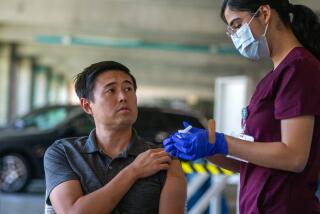L.A. County COVID-19 hospitalizations hit three-month low while MIS-C cases climb

- Share via
COVID-19 hospitalizations in Los Angeles County are at their lowest point since Thanksgiving, authorities said Thursday.
The number of COVID-19 patients hospitalized in the county as of Wednesday was 1,886, according to state figures released Thursday. Over the last week, COVID-19 hospitalizations have been falling an average of roughly 5% a day, and on Tuesday, L.A. County tallied 1,988 COVID-19 hospitalizations — the first time the number dipped below 2,000 since Nov. 26.
At the worst point in the pandemic, 8,098 people were hospitalized with COVID-19 in L.A. County, a number recorded on Jan. 5.
But whereas the numbers in November were increasing rapidly — COVID-19 hospitalizations rose by as much as 47% in a week in that month — they are now moving in the opposite direction. Since last week, countywide COVID-19 hospitalizations have fallen by 29%, while new daily identified coronavirus cases have dropped by 16%, according to a Times analysis.
The L.A. County Public Health Department said the daily positivity rate is just over 3%, down from more than 20% around Jan. 1.
Despite the good news, it is taking time for hospitals to recover from the surge. The county’s publicly run hospitals are still reporting a large number of COVID-19 patients with very long stays in intensive care units.
The county on Thursday also reported 10 additional cases of multisystem inflammatory syndrome, a serious inflammatory condition associated with COVID-19 that affects people under 21.
The additions bring the total number of MIS-C cases in L.A. County to 100 — a substantial increase from just over a month ago, when there were 62 children with MIS-C in the county.
“This increase in cases is a distressing delayed result of the surge we experienced in December and January,” the Public Health Department said in a statement, adding that most children with MIS-C were infected with COVID-19 at some point before their diagnosis.
Symptoms of MIS-C include fever that does not go away and inflamed body parts, including the heart, lungs, kidneys, brain, skin, eyes or gastrointestinal organs.
Of the 100 cases of MIS-C in the county, 30% were children under the age of 5, 40% were between 5 and 11, and 30% were between the ages of 12 and 20.
All 100 young people diagnosed with MIS-C in L.A. County were hospitalized, and 40% were treated in the ICU. One child died.
“To the many families mourning a loved one who passed away from COVID-19, we send you our deepest condolences,” L.A. County Public Health Director Barbara Ferrer said in a statement. “We continue to experience the repercussions from the January surge in our increased number of children with MIS-C.”
In L.A. County, the inflammatory syndrome has disproportionately affected Latino children, who account for 71% of the reported cases.
And though overall case and hospitalization numbers are declining, the county on Thursday reported an additional 109 COVID-19 deaths and 1,983 cases. Cumulative death numbers increased sharply on Wednesday when the county reported a backlog of more than 800 deaths over the autumn-and-winter surge that brought the statewide death toll beyond 50,000.
L.A. County has recorded a cumulative total of 21,106 COVID-19 deaths and 1.19 million confirmed cases.
Meanwhile, vaccination efforts continue to struggle against issues such as weather, limited doses and bungled efforts to direct shots to hard-hit communities. County officials from both L.A. and San Diego have said they continue to not get weeks of notice about incoming dose shipments, a problem that Gov. Gavin Newsom has said will be resolved soon.
Concerns are also growing about mutant variants of the coronavirus, including a California strain that new research strongly suggests spreads more readily than its predecessors.
But the fact that daily coronavirus cases are continuing to decline is gratifying, Dr. Eric McDonald, medical director of the San Diego County epidemiology department, said this week.
“So even if it is a little more contagious than the other ones that are circulating in the community, the take-home message is the same: that you need to do all the things that we’ve recommended to prevent transmission — so, wearing masks, social distancing, staying at home,” he told reporters Wednesday.
The coronavirus can’t mutate if it’s not infecting people, scientists say. And masks and social distancing are just as effective at preventing the spread of mutant strains.
“With continued spread of variants that ... threaten the progress we are making, we must recommit to doing our part to protect one another,” Dr. Rochelle Walensky, director of the U.S. Centers for Disease Control and Prevention, said recently. “Wear a well-fitting mask, social distance, avoid travel and crowds, practice good hand hygiene, and get vaccinated when the vaccine is available to you.”
Times staff writer Ryan Menezes contributed to this report.
More to Read
Sign up for Essential California
The most important California stories and recommendations in your inbox every morning.
You may occasionally receive promotional content from the Los Angeles Times.















